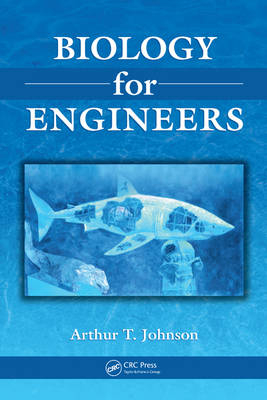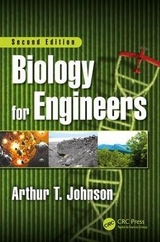
Biology for Engineers
Crc Press Inc (Verlag)
978-1-4200-7763-6 (ISBN)
- Titel erscheint in neuer Auflage
- Artikel merken
Biology is a critical application area for engineering analysis and design, and students in engineering programs must be well-versed in the fundamentals of biology as they relate to their field. Biology for Engineers is an introductory text that minimizes unnecessary memorization of connections and classifications and instead emphasizes concepts, technology, and the utilization of living things. Whether students are headed toward a bio-related engineering degree or one of the more traditional majors, biology is so important that all engineering students should know how living things work and act.
Classroom-tested at the University of Maryland, this comprehensive text introduces concepts and terminology needed to understand more advanced biology literature. Filled with practical detailed examples, the book presents:
Scientific principles relevant to biology that all engineers must know
A discussion of biological responses from the perspective of a broad range of fields such as psychology, human factors, genetics, plant and animal physiology, imaging, control systems, actuary, and medicine
A thorough examination of the scaling of biological responses and attributes
A classification of different types of applications related to biological systems
Tables of useful information that are nearly impossible to find elsewhere
A series of questions at the end of each chapter to test comprehension
Emphasizing the ever-present interactions between a biological unit and its physical, chemical, and biological environments, the book provides ample instruction on the basics of physics, chemistry, mathematics, and engineering. It brings together all of the concepts one needs to understand the role of biology in modern technology.
Arthur T. Johnson attended Cornell University for his undergraduate and graduate degrees and he earned his Ph.D. in 1969. He has been on the faculty of the University of Maryland since 1986. His research interests include human performance wearing respiratory protective masks, respiratory mechanics and measurement, and transport processes.
I. INTRODUCTION
Science and Engineering
Scientific Method
Mathematical Modeling
Biological Engineering
Expectations for Biological Engineers
About Predictions
About This Book
Questions
II. PRINCIPLES FROM THE SCIENCES
Principles of Physics
Effort and Flow Variables
Balances
States of Matter
Equivalence of Work and Energy
Free Energy
Disorder and Entropy
Heat Transfer
Movement of Materials
Fluid Mechanics
Solid Mechanics
Electricity
Temperature Effects
Questions
Principles of Chemistry
Periodic Nature of Elements
Chemical Bonding
Chemical Equilibrium
Acids and Bases
Reaction Rates
Carbon Chemistry
Physical Chemistry in Water
Protein Folding
Shape Effects and Enzymes
Energy-Rich Compounds
Temperature and Pressure Effects
Free Energy
Questions
Principles of Mathematics and Engineering Sciences
Equality
Randomness and Probability
Calculus
Control Systems
Optimization
Information
Analog and Digital Signal Processing
Questions
Principles of Biology
Form and Function
Modularity and Incremental Change
Genetic Basis
Competition and Selection
Biological Hierarchies
Is Biology Complex or Simple?
Questions
III. RESPONSES OF LIVING SYSTEMS
Biological Responses in Context
BU Need Water
BU Need the Right Amount of Oxygen
BU Need Food and Nutrients
BU Become Ill in the Presence of Wastes
BU Need Heat Sources and Sinks
BU Adapt to Their Environments
BU Modify Their Environments
Adaptations Require Extra Energy and Resources
BU, If Possible, Move to Friendlier Environments
BU Evolve under Environmental Pressures
Crowding of BU Produces Stress
BU Are Affected by Chemical Stresses
BU Respond to Mechanical Stresses
Optimization Is Used to Save Energy and Nutrient Resources
BU Alter Themselves to Protect against Harsh Environments
BU Cooperate with Other BU
BU Compete with Other BU
BU Reproduce
BU Coordinate Activities through Communication
BU Maintain Stability with Exquisite Control
BU Go Through Natural Cycles
BU Need Emotional Satisfaction and Intellectual Stimulation
BU Die
Questions
IV. SCALING FACTORS
Allometric Relationships from Evolutionary Pressure
Allometric Relationships from Evolutionary Pressure
Dimensional Analysis
Golden Ratio
Fractal Scaling within an Organism
Self-Similarity for Tissues and Organs
Plant Growth
Self-Similarity in Populations
Questions
V. UTILIZING LIVING SYSTEMS
Biological Engineering Solutions
Systems Approach
Relationships between Engineering and Biology
The Completed Design
Dénouement
Questions
APPENDICES
REFERENCES
INDEX
| Zusatzinfo | at least 240 equations; 66 Tables, black and white; 305 Illustrations, color |
|---|---|
| Verlagsort | Bosa Roca |
| Sprache | englisch |
| Maße | 178 x 254 mm |
| Gewicht | 1792 g |
| Themenwelt | Medizin / Pharmazie ► Physiotherapie / Ergotherapie ► Orthopädie |
| Naturwissenschaften ► Biologie | |
| Technik ► Medizintechnik | |
| ISBN-10 | 1-4200-7763-5 / 1420077635 |
| ISBN-13 | 978-1-4200-7763-6 / 9781420077636 |
| Zustand | Neuware |
| Haben Sie eine Frage zum Produkt? |
aus dem Bereich



